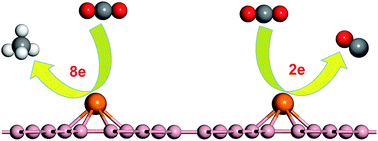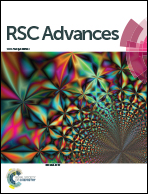Efficient electrocatalytic reduction of carbon dioxide by metal-doped β12-borophene monolayers†
Abstract
Electrochemical reduction of CO2 to value-added chemicals and fuels shows great promise in contributing to reducing the energy crisis and environment problems. This progress has been slowed by a lack of stable, efficient and selective catalysts. In this paper, density functional theory (DFT) was used to study the catalytic performance of the first transition metal series anchored TM–Bβ12 monolayers as catalysts for electrochemical reduction of CO2. The results show that the TM–Bβ12 monolayer structure has excellent catalytic stability and electrocatalytic selectivity. The primary reduction product of Sc–Bβ12 is CO and the overpotential is 0.45 V. The primary reduction product of the remaining metals (Ti–Zn) is CH4, where Fe–Bβ12 has the minimum overpotential of 0.45 V. Therefore, these new catalytic materials are exciting. Furthermore, the underlying reaction mechanisms of CO2 reduction via the TM–Bβ12 monolayers have been revealed. This work will shed insights on both experimental and theoretical studies of electroreduction of CO2.

- This article is part of the themed collections: Catalysis for sustainable development and Editors' collection: Carbon Dioxide Capture/Reduction


 Please wait while we load your content...
Please wait while we load your content...